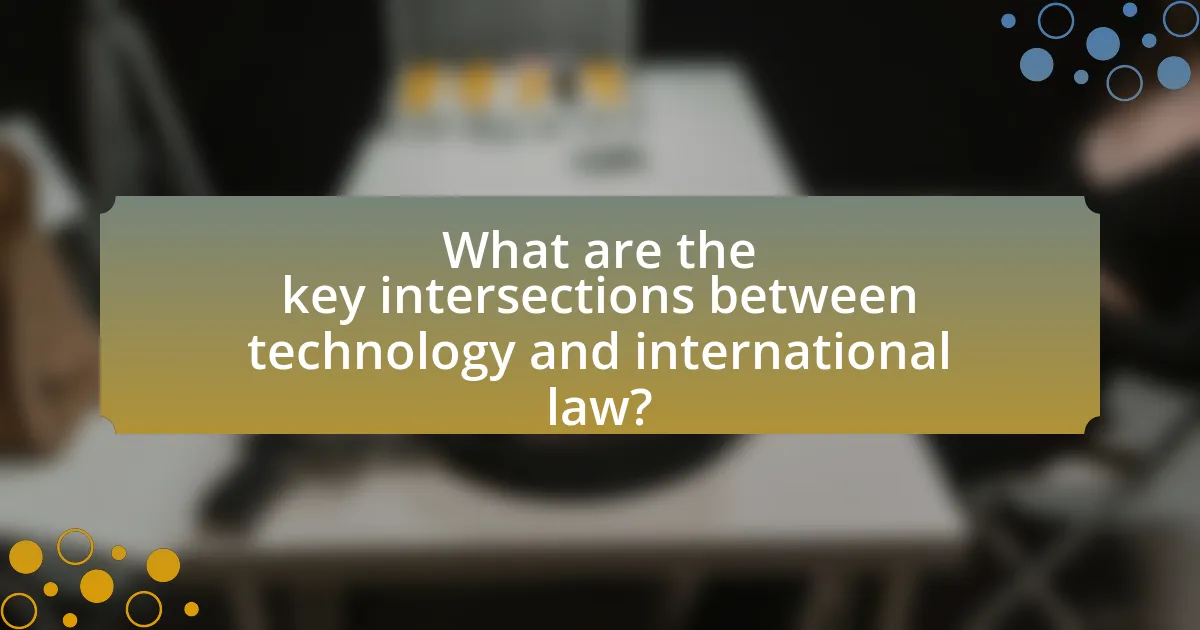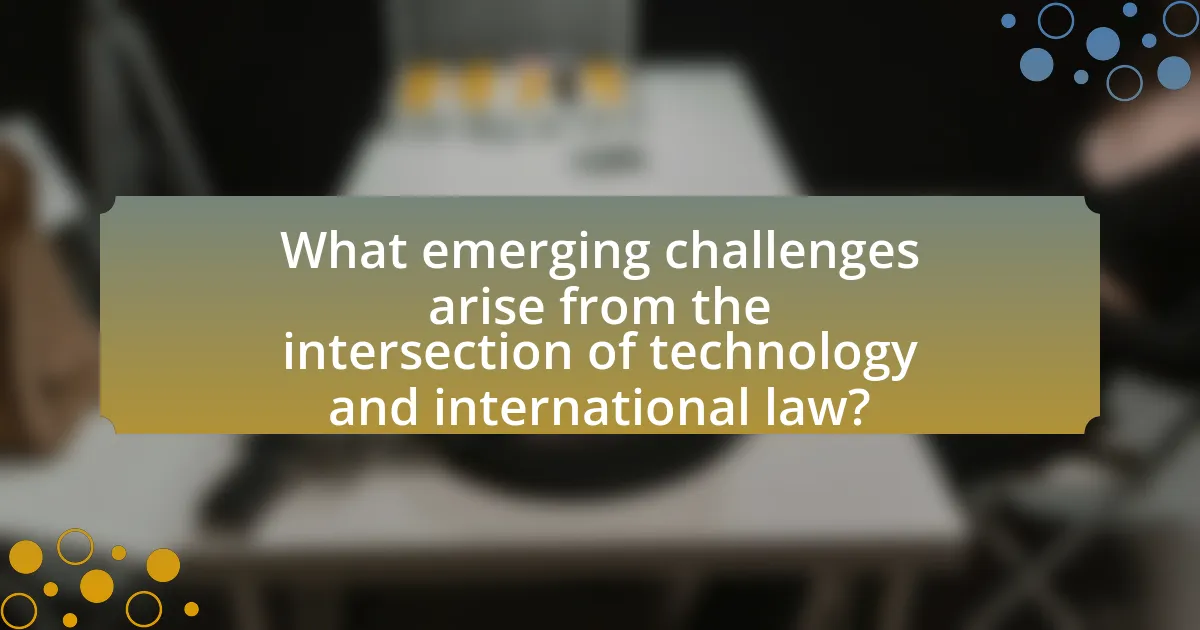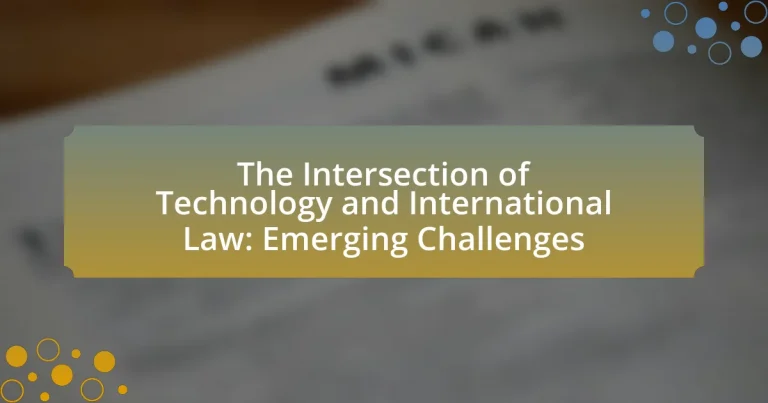The article examines the intersection of technology and international law, focusing on emerging challenges such as cybersecurity, data privacy, and the regulation of artificial intelligence and biotechnology. It highlights how advancements in technology influence the development of international legal frameworks, complicate issues of state sovereignty, and challenge existing legal norms. Key technologies impacting international law include AI, blockchain, and data privacy technologies, which necessitate adaptations in legal standards. The article also discusses the implications of these technological advancements on accountability, jurisdiction, and ethical considerations, emphasizing the need for international cooperation and updated legal frameworks to address these complexities effectively.

What are the key intersections between technology and international law?
The key intersections between technology and international law include cybersecurity, data privacy, and the regulation of emerging technologies such as artificial intelligence and biotechnology. Cybersecurity laws are increasingly relevant as states and organizations face threats from cyberattacks, necessitating international cooperation and legal frameworks to address these risks. Data privacy laws, such as the General Data Protection Regulation (GDPR) in the European Union, illustrate how technology impacts individual rights and international obligations regarding personal data protection. Furthermore, the regulation of emerging technologies, including AI and biotechnology, raises complex legal questions about liability, ethical standards, and compliance with international treaties, such as the Biological Weapons Convention. These intersections highlight the need for adaptive legal frameworks that can respond to rapid technological advancements while ensuring compliance with international norms and standards.
How has technology influenced the development of international law?
Technology has significantly influenced the development of international law by facilitating communication, enhancing data collection, and enabling the enforcement of legal norms across borders. The advent of the internet and digital communication has allowed for rapid dissemination of legal information and collaboration among states, leading to the creation of treaties and agreements that address global issues such as cybersecurity and climate change. For instance, the establishment of the Paris Agreement in 2015 was made possible through improved communication technologies that allowed for real-time negotiations and data sharing among nations. Additionally, advancements in surveillance and data analytics have raised new legal challenges regarding privacy and human rights, prompting the need for updated legal frameworks to protect individuals in the digital age. These developments illustrate how technology not only shapes the practice of international law but also necessitates its evolution to address emerging global challenges.
What specific technologies are impacting international legal frameworks?
Artificial intelligence, blockchain, and data privacy technologies are significantly impacting international legal frameworks. Artificial intelligence is reshaping legal processes through automation and predictive analytics, leading to new regulatory considerations regarding liability and accountability. Blockchain technology introduces challenges related to contract enforcement and jurisdiction, as it enables decentralized transactions that may not fit traditional legal paradigms. Data privacy technologies, particularly in light of regulations like the General Data Protection Regulation (GDPR), are prompting countries to reevaluate their legal standards for data protection and cross-border data flows. These technologies collectively necessitate adaptations in international law to address issues of compliance, enforcement, and ethical considerations.
How do advancements in technology challenge existing legal norms?
Advancements in technology challenge existing legal norms by creating scenarios that existing laws are ill-equipped to address. For instance, the rise of artificial intelligence and machine learning has led to questions about liability and accountability, as traditional legal frameworks often do not specify who is responsible for decisions made by autonomous systems. Additionally, the rapid development of digital currencies and blockchain technology has outpaced regulatory measures, leading to gaps in financial oversight and consumer protection. A notable example is the lack of comprehensive regulations governing cryptocurrencies, which has resulted in significant market volatility and fraud cases, highlighting the inadequacy of current financial laws to manage these innovations effectively.
What are the implications of technology on state sovereignty?
Technology significantly undermines state sovereignty by enabling transnational communication and data flow that bypasses traditional borders. The rise of the internet and digital platforms allows non-state actors, including corporations and individuals, to influence political processes and public opinion across nations, often without government oversight. For instance, social media platforms have been used to mobilize protests and disseminate information that challenges state authority, as seen during the Arab Spring. Additionally, cyber capabilities can lead to state-sponsored attacks on critical infrastructure, further eroding the control that states have over their own territory and citizens. The implications extend to legal frameworks, as international law struggles to keep pace with technological advancements, creating challenges in regulating activities that affect state sovereignty.
How does cyber warfare affect international relations and law?
Cyber warfare significantly impacts international relations and law by creating new challenges in state sovereignty, accountability, and the application of existing legal frameworks. The rise of cyber attacks, such as the 2010 Stuxnet attack on Iran’s nuclear facilities, illustrates how states can engage in covert operations that blur the lines of traditional warfare, complicating diplomatic relations and raising questions about the legality of such actions under international law. Furthermore, the lack of universally accepted norms and regulations governing cyber warfare leads to increased tensions among nations, as states may retaliate in ways that escalate conflicts. The Tallinn Manual on the International Law Applicable to Cyber Warfare provides a framework for understanding these issues, yet its non-binding nature highlights the ongoing struggle to adapt legal principles to the digital age.
What role does technology play in transnational governance?
Technology plays a crucial role in transnational governance by facilitating communication, data sharing, and coordination among states and international organizations. It enables real-time collaboration and decision-making, which is essential for addressing global challenges such as climate change, public health crises, and security threats. For instance, platforms like the Global Health Observatory utilize technology to share health data across borders, allowing for coordinated responses to pandemics. Additionally, blockchain technology is increasingly used for transparent and secure transactions in international trade, enhancing trust among nations. These technological advancements not only streamline governance processes but also promote accountability and efficiency in addressing transnational issues.

What emerging challenges arise from the intersection of technology and international law?
Emerging challenges at the intersection of technology and international law include issues related to cybersecurity, data privacy, and the regulation of artificial intelligence. Cybersecurity threats, such as state-sponsored hacking and cyber warfare, challenge existing legal frameworks that were not designed to address these modern threats. Data privacy concerns arise from the global nature of data flows, complicating jurisdiction and enforcement of laws like the General Data Protection Regulation (GDPR). Additionally, the rapid development of artificial intelligence raises questions about accountability, liability, and ethical standards, as current international law struggles to keep pace with technological advancements. These challenges necessitate a reevaluation of legal frameworks to ensure they are equipped to handle the complexities introduced by technology.
How do privacy concerns intersect with international legal standards?
Privacy concerns intersect with international legal standards through frameworks that aim to protect individual rights while balancing state interests. Various international treaties, such as the International Covenant on Civil and Political Rights, establish the right to privacy, obligating signatory states to respect and ensure this right. Additionally, the General Data Protection Regulation (GDPR) in the European Union sets a high standard for data protection, influencing global norms and prompting countries to align their laws with these international standards. This intersection is further evidenced by the increasing number of bilateral and multilateral agreements that address data privacy and cybersecurity, reflecting a growing recognition of privacy as a fundamental human right in the context of globalization and technological advancement.
What are the legal implications of data protection across borders?
The legal implications of data protection across borders include compliance with varying national laws, potential conflicts between jurisdictions, and the necessity for international agreements. Different countries have distinct data protection regulations, such as the General Data Protection Regulation (GDPR) in the European Union, which imposes strict rules on data transfer outside its borders. Non-compliance can lead to significant penalties, as seen with companies facing fines for violating GDPR provisions. Additionally, cross-border data flows may encounter legal challenges when national laws conflict, requiring organizations to navigate complex legal landscapes. International frameworks, like the Privacy Shield agreement between the U.S. and EU, aim to facilitate data transfer while ensuring adequate protection, but such agreements can be subject to legal scrutiny and changes, impacting their effectiveness.
How do different jurisdictions approach privacy in the digital age?
Different jurisdictions approach privacy in the digital age through varying legal frameworks and regulations. For instance, the European Union enforces the General Data Protection Regulation (GDPR), which mandates strict consent requirements and data protection rights for individuals, emphasizing transparency and accountability. In contrast, the United States adopts a sectoral approach, where privacy laws vary by industry, such as the Health Insurance Portability and Accountability Act (HIPAA) for healthcare and the California Consumer Privacy Act (CCPA) for consumer data, leading to a patchwork of protections. Additionally, countries like China implement comprehensive data control measures through the Personal Information Protection Law (PIPL), which prioritizes state security and data localization. These differences illustrate how cultural, legal, and political factors shape privacy regulations globally.
What challenges do artificial intelligence and automation pose to international law?
Artificial intelligence and automation pose significant challenges to international law, primarily due to issues of accountability, jurisdiction, and compliance with existing legal frameworks. The rapid development of AI technologies often outpaces the ability of international legal systems to adapt, leading to gaps in regulation. For instance, autonomous weapons systems raise questions about liability in warfare, as it becomes unclear who is responsible for actions taken by machines. Additionally, the cross-border nature of AI applications complicates jurisdictional issues, making it difficult to enforce laws consistently across different nations. Furthermore, the lack of universally accepted standards for AI ethics and governance creates challenges in ensuring compliance with international human rights obligations. These factors collectively hinder the effective regulation of AI and automation within the context of international law.
How can international law adapt to the rise of autonomous systems?
International law can adapt to the rise of autonomous systems by establishing clear legal frameworks that define accountability, liability, and ethical standards for their use. This adaptation is necessary as autonomous systems, such as drones and AI-driven military technologies, challenge existing legal norms regarding state responsibility and human rights. For instance, the United Nations has initiated discussions on the implications of autonomous weapons systems, emphasizing the need for regulations that ensure compliance with international humanitarian law. Additionally, countries like the United States and the European Union are developing guidelines that address the deployment of autonomous technologies, focusing on transparency and oversight to mitigate risks associated with their use. These efforts demonstrate a proactive approach to integrating autonomous systems into the legal landscape, ensuring that international law remains relevant and effective in addressing emerging technological challenges.
What ethical considerations arise from AI in legal contexts?
Ethical considerations arising from AI in legal contexts include issues of bias, accountability, transparency, and privacy. Bias in AI algorithms can lead to discriminatory outcomes in legal decisions, as evidenced by studies showing that machine learning models can perpetuate existing societal biases. Accountability becomes complex when AI systems make decisions, raising questions about who is responsible for errors or injustices caused by these systems. Transparency is crucial, as legal professionals and affected individuals need to understand how AI systems reach their conclusions; however, many AI models operate as “black boxes,” obscuring their decision-making processes. Privacy concerns also emerge, particularly regarding the handling of sensitive personal data by AI systems, which can conflict with legal standards for data protection. These ethical considerations highlight the need for careful regulation and oversight of AI technologies in the legal field to ensure fairness and justice.

How can international law evolve to address these challenges?
International law can evolve to address challenges posed by technology through the development of new treaties and frameworks that specifically target issues such as cybersecurity, data privacy, and artificial intelligence governance. For instance, the establishment of international agreements similar to the Paris Agreement for climate change could facilitate cooperation among nations to set standards for technology use and data protection. Additionally, organizations like the United Nations have begun initiatives to create guidelines for the ethical use of AI, reflecting a growing recognition of the need for legal structures that adapt to technological advancements. This evolution is supported by the increasing number of cyberattacks and data breaches, which highlight the inadequacies of current legal frameworks in protecting nations and individuals.
What strategies can be implemented to harmonize international legal standards with technological advancements?
To harmonize international legal standards with technological advancements, countries can adopt a framework of collaborative international treaties that address emerging technologies. This approach allows nations to establish common legal principles and guidelines that adapt to rapid technological changes, ensuring consistency across jurisdictions. For instance, the General Data Protection Regulation (GDPR) in the European Union serves as a model for data protection laws that can inspire similar regulations globally, promoting uniformity in privacy standards. Additionally, engaging stakeholders from the tech industry, legal experts, and civil society in the drafting process can enhance the relevance and applicability of these legal standards, as seen in initiatives like the OECD’s Principles on Artificial Intelligence. Such collaborative efforts can lead to more effective governance of technology while respecting diverse legal traditions and cultural contexts.
How can international cooperation enhance legal responses to technology-related issues?
International cooperation can enhance legal responses to technology-related issues by facilitating the development of unified legal frameworks and standards that address cross-border challenges. Collaborative efforts among nations enable the sharing of best practices, resources, and expertise, which is essential for effectively tackling issues such as cybercrime, data privacy, and intellectual property rights. For instance, the Budapest Convention on Cybercrime exemplifies how international agreements can provide a legal basis for cooperation in combating cybercrime, allowing countries to work together in investigations and prosecutions. Additionally, organizations like the International Telecommunication Union promote global dialogue and policy development, ensuring that legal responses are adaptable to rapid technological advancements. This collaborative approach not only strengthens legal mechanisms but also fosters trust and mutual understanding among nations, which is crucial for addressing the complexities of technology-related legal challenges.
What role do international organizations play in shaping technology-related laws?
International organizations play a crucial role in shaping technology-related laws by establishing frameworks, guidelines, and standards that member states adopt and implement. For instance, the International Telecommunication Union (ITU) facilitates global cooperation on telecommunications and internet governance, influencing national regulations through treaties and recommendations. Additionally, organizations like the World Trade Organization (WTO) address trade-related aspects of technology, promoting policies that affect intellectual property rights and digital trade. These organizations provide platforms for dialogue, enabling countries to negotiate and harmonize laws, which is essential for addressing cross-border technology issues such as cybersecurity and data protection.
What best practices can be adopted by legal professionals in navigating technology-related challenges?
Legal professionals can adopt several best practices to navigate technology-related challenges effectively. First, they should prioritize continuous education on emerging technologies, such as artificial intelligence and blockchain, to understand their implications on legal frameworks. For instance, the American Bar Association emphasizes the importance of legal professionals staying informed about technological advancements to provide competent representation.
Second, legal professionals should implement robust cybersecurity measures to protect sensitive client information, as data breaches can lead to significant legal liabilities. According to a report by the International Association of Privacy Professionals, 79% of organizations experienced a data breach in 2020, highlighting the critical need for effective data protection strategies.
Third, collaboration with technology experts can enhance legal professionals’ ability to address complex technology-related issues. Engaging with IT specialists can help legal teams understand the technical aspects of cases involving technology, ensuring comprehensive legal analysis.
Lastly, adopting technology tools for case management and research can streamline workflows and improve efficiency. A study by the Legal Technology Resource Center found that law firms utilizing technology tools reported a 30% increase in productivity, demonstrating the tangible benefits of integrating technology into legal practice.
How can legal practitioners stay informed about technological developments?
Legal practitioners can stay informed about technological developments by engaging in continuous education through specialized courses, attending industry conferences, and subscribing to relevant legal technology journals. Continuous education programs, such as those offered by the American Bar Association, provide updates on emerging technologies and their implications for law. Industry conferences, like the LegalTech Conference, facilitate networking and knowledge sharing among professionals. Subscribing to journals such as the Harvard Journal of Law & Technology offers insights into recent advancements and case studies. These methods ensure that legal practitioners remain knowledgeable about the evolving technological landscape and its impact on international law.
What resources are available for understanding the intersection of technology and international law?
Resources available for understanding the intersection of technology and international law include academic journals, books, online courses, and research papers. Notable academic journals such as the “Harvard International Law Journal” and the “Journal of International Economic Law” frequently publish articles on technology-related legal issues. Books like “Cybersecurity and International Law” by Paul Rosenzweig provide in-depth analysis of specific topics. Online platforms such as Coursera and edX offer courses on international law that include modules on technology. Research papers from institutions like the International Institute for Strategic Studies and the United Nations Office for Disarmament Affairs also provide valuable insights into emerging challenges at this intersection.


